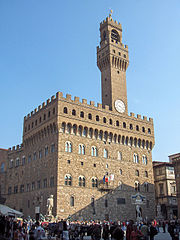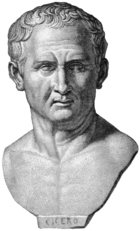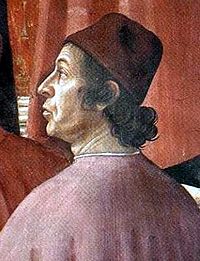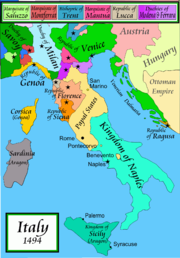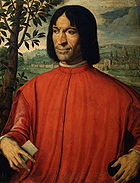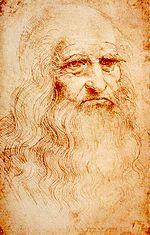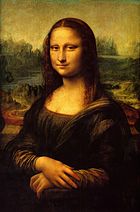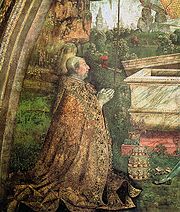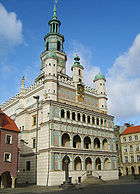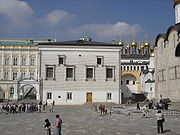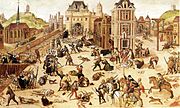
Renaissance
Background Information
SOS Children offer a complete download of this selection for schools for use on schools intranets. Sponsor a child to make a real difference.
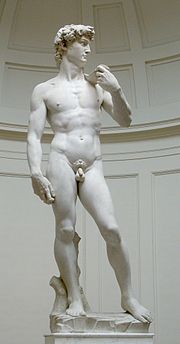
The Renaissance (Italian: Rinascimento, French: Renaissance, from ri- "again" and nascere "be born") is a cultural movement that spanned roughly the 14th to the 17th century, beginning in Florence in the Late Middle Ages and later spreading to the rest of Europe. The term is also used more loosely to refer to the historic era, but since the changes of the Renaissance were not uniform across Europe, this is a general use of the term. As a cultural movement, it encompassed a resurgence of learning based on classical sources, the development of linear perspective in painting, and gradual but widespread educational reform. Traditionally, this intellectual transformation has resulted in the Renaissance being viewed as a bridge between the Middle Ages and the Modern era. Although the Renaissance saw revolutions in many intellectual pursuits, as well as social and political upheaval, it is perhaps best known for its artistic developments and the contributions of such polymaths as Leonardo da Vinci and Michelangelo, who inspired the term " Renaissance man".
There is a general, but not unchallenged, consensus that the Renaissance began in Florence, Tuscany in the 14th century. Various theories have been proposed to account for its origins and characteristics, focusing on a variety of factors including the social and civic peculiarities of Florence at the time; its political structure; the patronage of its dominant family, the Medici; and the migration of Greek scholars and texts to Italy following the Fall of Constantinople at the hands of the Ottoman Turks.
The Renaissance has a long and complex historiography, and there has been much debate among historians as to the usefulness of Renaissance as a term and as a historical delineation. Some have called into question whether the Renaissance was a cultural "advance" from the Middle Ages, instead seeing it as a period of pessimism and nostalgia for the classical age, while others have instead focused on the continuity between the two eras. Indeed, some have called for an end to the use of the term, which they see as a product of presentism – the use of history to validate and glorify modern ideals. The word Renaissance has also been used to describe other historical and cultural movements, such as the Carolingian Renaissance and the Renaissance of the 12th century.
Overview
| Renaissance |
|---|
 |
| Topics |
|
| Regions |
|
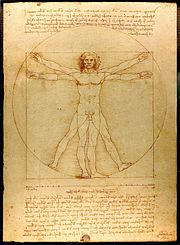
Leonardo da Vinci's Vitruvian Man shows clearly the effect writers of Antiquity had on Renaissance thinkers. Based on the specifications in Vitruvius's De architectura around 1500 years before, Da Vinci tried to draw the perfectly proportioned man.
|
The Renaissance was a cultural movement that profoundly affected European intellectual life in the early modern period. Beginning in Italy, and spreading to the rest of Europe by the 16th century, its influence affected literature, philosophy, art, politics, science, religion, and other aspects of intellectual inquiry. Renaissance scholars employed the humanist method in study, and searched for realism and human emotion in art.
Renaissance thinkers sought out in Europe's monastic libraries and the crumbling Byzantine Empire the literary, historical, and oratorical texts of antiquity, typically written in Latin or ancient Greek, many of which had fallen into obscurity. It is in their new focus on literary and historical texts that Renaissance scholars differed so markedly from the medieval scholars of the Renaissance of the 12th century, who had focused on studying Greek and Arabic works of natural sciences, philosophy and mathematics, rather than on such cultural texts. Renaissance humanists did not reject Christianity; quite the contrary, many of the Renaissance's greatest works were devoted to it, and the Church patronized many works of Renaissance art. However, a subtle shift took place in the way that intellectuals approached religion that was reflected in many other areas of cultural life. In addition, many Greek Christian works, including the Greek New Testament, were brought back from Byzantium to Western Europe and engaged Western scholars for the first time since late antiquity. This new engagement with Greek Christian works, and particularly the return to the original Greek of the New Testament promoted by humanists Lorenzo Valla and Erasmus, would help pave the way for the Protestant Reformation.
Artists such as Masaccio strove to portray the human form realistically, developing techniques to render perspective and light more naturally. Political philosophers, most famously Niccolò Machiavelli, sought to describe political life as it really was, that is to understand it rationally. A critical contribution to Italian Renaissance humanism Pico della Mirandola wrote the famous text "De hominis dignitate" ( Oration on the Dignity of Man, 1486), which consists of a series of theses on philosophy, natural thought, faith and magic defended against any opponent on the grounds of reason. In addition to studying classical Latin and Greek, Renaissance authors also began increasingly to use vernacular languages; combined with the introduction of printing, this would allow many more people access to books, especially the Bible.
In all, the Renaissance could be viewed as an attempt by intellectuals to study and improve the secular and worldly, both through the revival of ideas from antiquity, and through novel approaches to thought. Some scholars, such as Rodney Stark, play down the Renaissance in favour of the earlier innovations of the Italian city states in the High Middle Ages, which married responsive government, Christianity and the birth of capitalism. This analysis argues that, whereas the great European states (France and Spain) were absolutist monarchies, and others were under direct Church control, the independent city republics of Italy took over the principles of capitalism invented on monastic estates and set off a vast unprecedented commercial revolution which preceded and financed the Renaissance.
Origins
Most historians agree that the ideas that characterized the Renaissance had their origin in late 13th century Florence, in particular with the writings of Dante Alighieri (1265–1321) and Francesco Petrarca (1304–1374), as well as the painting of Giotto di Bondone (1267–1337). Some writers date the Renaissance quite precisely; one proposed starting point is 1401, when the rival geniuses Lorenzo Ghiberti and Filippo Brunelleschi competed for the contract to build the bronze doors for the Baptistery of the Florence Cathedral (Ghiberti won). Others see more general competition between artists and polymaths such as Brunelleschi, Ghiberti, Donatello, and Masaccio for artistic commissions as sparking the creativity of the Renaissance. Yet it remains much debated why the Renaissance began in Italy, and why it began when it did. Accordingly, several theories have been put forward to explain its origins.
During the Renaissance, money and art went hand in hand. Artists depended totally on patrons while the patrons needed money to sustain genuises. Wealth was brought to Italy in the 14th, 15th, and 16th centuries by expanding trade into Asia and Europe. Silver mining in Tyrol increased the flow of money. Luxuries from the Eastern world, brought home during the Crusades, increased the prosperity of Genoa and Venice.
Latin and Greek Phases of Renaissance humanism
In stark contrast to the High Middle Ages, when Latin scholars focused almost entirely on studying Greek and Arabic works of natural science, philosophy and mathematics, Renaissance scholars were most interested in recovering and studying Latin and Greek literary, historical, and oratorical texts. Broadly speaking, this began in the 14th century with a Latin phase, when Renaissance scholars such as Petrarch, Coluccio Salutati (1331–1406), Niccolò de' Niccoli (1364–1437) and Poggio Bracciolini (1380–1459 AD) scoured the libraries of Europe in search of works by such Latin authors as Cicero, Livy and Seneca. By the early 15th century, the bulk of such Latin literature had been recovered; the Greek phase of Renaissance humanism was now under way, as Western European scholars turned to recovering ancient Greek literary, historical, oratorical and theological texts.
Unlike the case of Latin texts, which had been preserved and studied in Western Europe since late antiquity, the study of ancient Greek texts was very limited in medieval Western Europe. Ancient Greek works on science, maths and philosophy had been studied since the High Middle Ages in Western Europe and in the medieval Islamic world, but Greek literary, oratorical and historical works, (such as Homer, the Greek dramatists, Demosthenes and Thucydides and so forth), were not studied in either the Latin or medieval Islamic worlds; in the Middle Ages these sorts of texts were only studied by Byzantine scholars. One of the greatest achievements of Renaissance scholars was to bring this entire class of Greek cultural works back into Western Europe for the first time since late antiquity. This movement to reintegrate the regular study of Greek literary, historical, oratorical and theological texts back into the Western European curriculum is usually dated to Coluccio Salutati's invitation to the Byzantine diplomat and scholar Manuel Chrysoloras (c.1355–1415) to Florence to teach Greek, his knowledge of the Greek language was of significant importance. Another Greek Byzantine scholar of importance was Demetrius Chalcondyles (1424 – 1511) who taught Platonic philosophy and the Greek language in Italy for a period of over forty years; at Padua, Perugia, Milan and Florence. Among his pupils were Johann Reuchlin, Janus Lascaris, Poliziano, Leo X, Baldassare Castiglione, Giglio Gregorio Giraldi, Stefano Negri, and Giovanni Maria Cattaneo.
The fall of the Byzantine Empire in 1453, accompanied by the closure of its schools of higher learning by the Ottoman Turks, brought many other Greek scholars to Italy and beyond, who brought with them Greek manuscripts, and knowledge of the classical Greek literature, some of which had been lost for centuries in the West.
Social and political structures in Italy
The unique political structures of late Middle Ages Italy have led some to theorize that its unusual social climate allowed the emergence of a rare cultural efflorescence. Italy did not exist as a political entity in the early modern period. Instead, it was divided into smaller city states and territories: the Kingdom of Naples controlled the south, the Republic of Florence and the Papal States at the centre, the Milanese and the Genoese to the north and west respectively, and the Venetians to the east. Fifteenth-century Italy was one of the most urbanised areas in Europe. Many of its cities stood among the ruins of ancient Roman buildings; it seems likely that the classical nature of the Renaissance was linked to its origin in the Roman Empire's heartland.
Historian and political philosopher Quentin Skinner points out that Otto of Freising (c. 1114 - 1158), a German bishop visiting north Italy during the 12th century, noticed a widespread new form of political and social organization, observing that Italy appeared to have exited from Feudalism so that its society was based on merchants and commerce. Linked to this was anti-monarchical thinking, represented in the famous early Renaissance fresco cycle Allegory of Good and Bad Government in Siena by Ambrogio Lorenzetti (painted 1338–1340) whose strong message is about the virtues of fairness, justice, republicanism and good administration. Holding both Church and Empire at bay, these city republics were devoted to notions of liberty. Skinner reports that there were many defences of liberty such as Matteo Palmieri's (1406–1475) celebration of Florentine genius not only in art, sculpture and architecture, but "the remarkable efflorescence of moral, social and political philosophy that occurred in Florence at the same time".
Even cities and states beyond central Italy, such as the Republic of Florence at this time, were also notable for their merchant Republics, especially the Republic of Venice. Although in practice these were oligarchical, and bore little resemblance to a modern democracy, they did have democratic features and were responsive states, with forms of participation in governance and belief in liberty. The relative political freedom they afforded was conducive to academic and artistic advancement. Likewise, the position of Italian cities such as Venice as great trading centres made them intellectual crossroads. Merchants brought with them ideas from far corners of the globe, particularly the Levant. Venice was Europe's gateway to trade with the East, and a producer of fine glass, while Florence was a capital of textiles. The wealth such business brought to Italy meant large public and private artistic projects could be commissioned and individuals had more leisure time for study.
Black Death
One theory that has been advanced is that the devastation caused by the Black Death in Florence, which hit Europe between 1348 and 1350, resulted in a shift in the world view of people in 14th-century Italy. Italy was particularly badly hit by the plague, and it has been speculated that the resulting familiarity with death caused thinkers to dwell more on their lives on Earth, rather than on spirituality and the afterlife. It has also been argued that the Black Death prompted a new wave of piety, manifested in the sponsorship of religious works of art. However, this does not fully explain why the Renaissance occurred specifically in Italy in the 14th century. The Black Death was a pandemic that affected all of Europe in the ways described, not only Italy. The Renaissance's emergence in Italy was most likely the result of the complex interaction of the above factors.
Cultural conditions in Florence
It has long been a matter of debate why the Renaissance began in Florence, and not elsewhere in Italy. Scholars have noted several features unique to Florentine cultural life which may have caused such a cultural movement. Many have emphasized the role played by the Medici, a banking family and later ducal ruling house, in patronizing and stimulating the arts. Lorenzo de' Medici (1449–1492) was the catalyst for an enormous amount of arts patronage, encouraging his countryman to commission works from Florence's leading artists, including Leonardo da Vinci, Sandro Botticelli, and Michelangelo Buonarroti.
The Renaissance was certainly underway before Lorenzo came to power; indeed, before the Medici family itself achieved hegemony in Florentine society. Some historians have postulated that Florence was the birthplace of the Renaissance as a result of luck, i.e. because " Great Men" were born there by chance. Da Vinci, Botticelli and Michelangelo were all born in Tuscany. Arguing that such chance seems improbable, other historians have contended that these "Great Men" were only able to rise to prominence because of the prevailing cultural conditions at the time.
Characteristics
Humanism
In some ways Humanism was not a philosophy per se, but rather a method of learning. In contrast to the medieval scholastic mode, which focused on resolving contradictions between authors, humanists would study ancient texts in the original, and appraise them through a combination of reasoning and empirical evidence. Humanist education was based on the programme of 'Studia Humanitatis', that being the study of five humanities: poetry, grammar, history, moral philosophy and rhetoric. Although historians have sometimes struggled to define humanism precisely, most have settled on "a middle of the road definition... the movement to recover, interpret, and assimilate the language, literature, learning and values of ancient Greece and Rome". Above all, humanists asserted "the genius of man ... the unique and extraordinary ability of the human mind."
Humanist scholars shaped the intellectual landscape throughout the early modern period. Political philosophers such as Niccolò Machiavelli and Thomas More revived the ideas of Greek and Roman thinkers, and applied them in critiques of contemporary government. Pico della Mirandola wrote what is often considered the manifesto of the Renaissance, a vibrant defence of thinking, the Oration on the Dignity of Man. Matteo Palmieri (1406–1475), another humanist, is most known for his work Della vita civile ("On Civic Life"; printed 1528) which advocated civic humanism, and his influence in refining the Tuscan vernacular to the same level as Latin. Palmieri's written works drawn on Roman philosophers and theorists, especially Cicero, who, like Palmieri, lived an active public life as a citizen and official, as well as a theorist and philosopher and also Quintilian. Perhaps the most succinct expression of his perspective on humanism is in a 1465 poetic work La città di vita, but an earlier work Della vita civile (On Civic Life) is more wide-ranging. Composed as a series of dialogues set in a country house in the Mugello countryside outside Florence during the plague of 1430, Palmieri expounds on the qualities of the ideal citizen. The dialogues include ideas about how children develop mentally and physically, how citizens can conduct themselves morally, how citizens and states can ensure probity in public life, and an important debate on the difference between that which is pragmatically useful and that which is honest.
Art

One of the distinguishing features of Renaissance art was its development of highly realistic linear perspective. Giotto di Bondone (1267–1337) is credited with first treating a painting as a window into space, but it was not until the demonstrations of architect Filippo Brunelleschi (1377–1446) and the subsequent writings of Leon Battista Alberti (1404–1472) that perspective was formalized as an artistic technique. The development of perspective was part of a wider trend towards realism in the arts. To that end, painters also developed other techniques, studying light, shadow, and, famously in the case of Leonardo da Vinci, human anatomy. Underlying these changes in artistic method, was a renewed desire to depict the beauty of nature, and to unravel the axioms of aesthetics, with the works of Leonardo, Michelangelo and Raphael representing artistic pinnacles that were to be much imitated by other artists. Other notable artists include Sandro Botticelli, working for the Medici in Florence, Donatello another Florentine and Titian in Venice, among others.
Concurrently, in the Netherlands, a particularly vibrant artistic culture developed, the work of Hugo van der Goes and Jan van Eyck having particular influence on the development of painting in Italy, both technically with the introduction of oil paint and canvas, and stylistically in terms of naturalism in representation. (For more, see Renaissance in the Netherlands). Later, the work of Pieter Brueghel the Elder would inspire artists to depict themes of everyday life.
In architecture, Filippo Brunelleschi was foremost in studying the remains of ancient classical buildings, and with rediscovered knowledge from the 1st-century writer Vitruvius and the flourishing discipline of mathematics, formulated the Renaissance style which emulated and improved on classical forms. Brunelleschi's major feat of engineering was the building of the dome of Florence Cathedral. The first building to demonstrate this is claimed to be the church of St. Andrew built by Alberti in Mantua. The outstanding architectural work of the High Renaissance was the rebuilding of St. Peter's Basilica, combining the skills of Bramante, Michelangelo, Raphael, Sangallo and Maderno.
The Roman orders types of columns are used: Tuscan, Doric, Ionic, Corinthian and Composite. These can either be structural, supporting an arcade or architrave, or purely decorative, set against a wall in the form of pilasters. During the Renaissance, architects aimed to use columns, pilasters, and entablatures as an integrated system. One of the first buildings to use pilasters as an integrated system was in the Old Sacristy (1421–1440) by Filippo Brunelleschi.
Arches, semi-circular or (in the Mannerist style) segmental, are often used in arcades, supported on piers or columns with capitals. There may be a section of entablature between the capital and the springing of the arch. Alberti was one of the first to use the arch on a monumental. Renaissance vaults do not have ribs. They are semi-circular or segmental and on a square plan, unlike the Gothic vault which is frequently rectangular.
Science
The upheavals occurring in the arts and humanities were mirrored by a dynamic period of change in the sciences. Some have seen this flurry of activity as a " scientific revolution", heralding the beginning of the modern age. Others have seen it merely as an acceleration of a continuous process stretching from the ancient world to the present day. Regardless, there is general agreement that the Renaissance saw significant changes in the way the universe was viewed and the methods with which philosophers sought to explain natural phenomena.
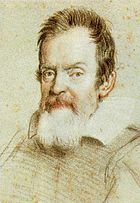
Science and art were very much intermingled in the early Renaissance, with artists such as Leonardo da Vinci making observational drawings of anatomy and nature. An exhaustive 2007 study by Fritjof Capra shows that Leonardo was a much greater scientist than previously thought, and not just an inventor. In science theory and in conducting actual science practice, Leonardo was innovative. He set up controlled experiments in water flow, medical dissection, and systematic study of movement and aerodynamics; he devised principles of research method that for Capra classify him as "father of modern science". In Capra's detailed assessment of many surviving manuscripts Leonardo's science is more in tune with holistic non-mechanistic and non-reductive approaches to science which are becoming popular today. Perhaps the most significant development of the era was not a specific discovery, but rather a process for discovery, the scientific method. This revolutionary new way of learning about the world focused on empirical evidence, the importance of mathematics, and discarded the Aristotelian " final cause" in favour of a mechanical philosophy. Early and influential proponents of these ideas included Copernicus, Galileo, Newton and René Descartes
The new scientific method led to great contributions in the fields of astronomy, physics, biology, and anatomy. With the publication of Vesalius's De humani corporis fabrica, a new confidence was placed in the role of dissection, observation, and a mechanistic view of anatomy.
Religion
The new ideals of humanism, although more secular in some aspects, developed against a Christian backdrop, especially in the Northern Renaissance. Indeed, much (if not most) of the new art was commissioned by or in dedication to the Church. However, the Renaissance had a profound effect on contemporary theology, particularly in the way people perceived the relationship between man and God. Many of the period's foremost theologians were followers of the humanist method, including Erasmus, Zwingli, Thomas More, Martin Luther, and John Calvin.
The Renaissance began in times of religious turmoil. The late Middle Ages saw a period of political intrigue surrounding the Papacy, culminating in the Western Schism, in which three men simultaneously claimed to be true Bishop of Rome. While the schism was resolved by the Council of Constance (1414), the 15th century saw a resulting reform movement known as Conciliarism, which sought to limit the pope's power. Although the papacy eventually emerged supreme in ecclesiastical matters by the Fifth Council of the Lateran (1511), it was dogged by continued accusations of corruption, most famously in the person of Pope Alexander VI, who was accused variously of simony, nepotism and fathering four illegitimate children whilst Pope, whom he married off to gain more power.
Churchmen such as Erasmus and Luther proposed reform to the Church, often based on humanist textual criticism of the New Testament. Indeed, it was Luther who in October 1517 published the 95 Theses, challenging papal authority and criticizing its perceived corruption, particularly with regard to its sale of indulgences. The 95 Theses led to the Reformation, a break with the Roman Catholic Church that previously claimed hegemony in Western Europe. Humanism and the Renaissance therefore played a direct role in sparking the Reformation, as well as in many other contemporaneous religious debates and conflicts.
Self-awareness
By the 15th century, writers, artists and architects in Italy were well aware of the transformations that were taking place and were using phrases like modi antichi (in the antique manner) or alle romana et alla antica (in the manner of the Romans and the ancients) to describe their work. The term la rinascita (rebirth) first appeared, however, in its broad sense in Giorgio Vasari's Vite de' più eccellenti architetti, pittori, et scultori Italiani (The Lives of the Artists, 1550, revised 1568). Vasari divides the age into three phases: the first phase contains Cimabue, Giotto, and Arnolfo di Cambio; the second phase contains Masaccio, Brunelleschi, and Donatello; the third centers on Leonardo da Vinci and culminates with Michelangelo. It was not just the growing awareness of classical antiquity that drove this development, according to Vasari, but also the growing desire to study and imitate nature.
Spread
In the 15th century, the Renaissance spread with great speed from its birthplace in Florence, first to the rest of Italy, and soon to the rest of Europe. The invention of the printing press allowed the rapid transmission of these new ideas. As it spread, its ideas diversified and changed, being adapted to local culture. In the 20th century, scholars began to break the Renaissance into regional and national movements.
Italy
While Renaissance ideas were moving north from Italy, there was a simultaneous southward spread of some areas of innovation, particularly in music. The music of the 15th century Burgundian School defined the beginning of the Renaissance in that art and the polyphony of the Netherlanders, as it moved with the musicians themselves into Italy, formed the core of what was the first true international style in music since the standardization of Gregorian Chant in the 9th century. The culmination of the Netherlandish school was in the music of the Italian composer, Palestrina. At the end of the 16th century Italy again became a centre of musical innovation, with the development of the polychoral style of the Venetian School, which spread northward into Germany around 1600.
The paintings of the Italian Renaissance differed from those of the Northern Renaissance. Italian Renaissance artists were among the first to paint secular scenes, breaking away from the purely religious art of medieval painters. At first, Northern Renaissance artists remained focused on religious subjects, such as the contemporary religious upheaval portrayed by Albrecht Dürer. Later on, the works of Pieter Bruegel influenced artists to paint scenes of daily life rather than religious or classical themes. It was also during the Northern Renaissance that Flemish brothers Hubert and Jan van Eyck perfected the oil painting technique, which enabled artists to produce strong colors on a hard surface that could survive for centuries. A feature of the Northern Renaissance was its use of the vernacular in place of Latin or Greek, which allowed greater freedom of expression. This movement had started in Italy with the decisive influence of Dante Alighieri on the development of vernacular languages; in fact the focus on writing in Italian has neglected a major source of Florentine ideas expressed in Latin. The spread of the technology of the German invention of movable type printing boosted the Renaissance, in Northern Europe as elsewhere; with Venice becoming a world centre of printing.
Portugal
In Portugal, the Renaissance arrived through the influence of the wealthy Italian merchants that started investing their money in the profitable Indian commerce that Portugal had monopolized during the late 15th century. Lisbon flourished, and writers such as Gil Vicente, Sá de Miranda, Bernardim Ribeiro and Luís de Camões and artists such as Nuno Gonçalves appeared.
Croatia
Spain
The Renaissance arrived in the Iberian peninsula through the Mediterranean possessions of the Aragonese Crown and the city of Valencia. Indeed, many of the early Spanish Renaissance writers come from the Kingdom of Aragon, including Ausiàs March and Joanot Martorell. In the Kingdom of Castile, the early Renaissance was heavily influenced by the Italian humanism, starting with writers and poets starting with the Marquis of Santillana, who introduced the new Italian poetry to Spain in the early 15th century. Other writers, such as Jorge Manrique, Fernando de Rojas, Juan del Encina, Juan Boscán Almogáver and Garcilaso de la Vega, kept a close resemblance to the Italian canon. Miguel de Cervantes's masterpiece Don Quixote is credited as the first Western novel. Renaissance humanism flourished in the early 16th century, with influential writers such as philosopher Juan Luis Vives, grammarian Antonio de Nebrija or natural historian Pedro de Mexía.
Later Spanish Renaissance tended towards religious themes and mysticism, with poets such as fray Luis de León, Teresa of Ávila and John of the Cross, and treated issues related to the exploration of the New World, with chroniclers and writers such as Inca Garcilaso de la Vega or Bartolomé de las Casas, giving rise to a body of work, now known as Spanish Renaissance literature. The late Renaissance in Spain also saw the rise of artists such as El Greco, and composers such as Tomás Luis de Victoria and Antonio de Cabezón.
Northern Europe
The Renaissance as it occurred in Northern Europe has been termed the "Northern Renaissance".
England
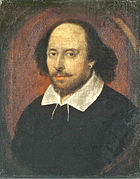
In England, the Elizabethan era marked the beginning of the English Renaissance with the work of writers William Shakespeare, Christopher Marlowe, Edmund Spenser, Sir Thomas More, Francis Bacon, Sir Philip Sidney, John Milton, as well as great artists, architects (such as Inigo Jones who introduced Italianate architecture to England), and composers such as Thomas Tallis, John Taverner, and William Byrd.
France
In 1495 the Italian Renaissance arrived in France, imported by King Charles VIII after his invasion of Italy. A factor that promoted the spread of secularism was the Church's inability to offer assistance against the Black Death. Francis I imported Italian art and artists, including Leonardo da Vinci, and built ornate palaces at great expense. Writers such as François Rabelais, Pierre de Ronsard, Joachim du Bellay and Michel de Montaigne, painters such as Jean Clouet and musicians such as Jean Mouton also borrowed from the spirit of the Italian Renaissance.
In 1533, a fourteen-year old Caterina de' Medici, (1519–1589) born in Florence to Lorenzo II de' Medici and Madeleine de la Tour d'Auvergne married Henry, second son of King Francis I and Queen Claude. Though she became famous and infamous for her role in France's religious wars, she made a direct contribution in bringing arts, sciences and music (including the origins of ballet) to the French court from her native Florence.
Germany
In the second half of the 15th century, the spirit of the age spread to Germany and the Low Countries, where the development of the printing press (ca. 1450) and early Renaissance artists like the painters Jan van Eyck (1395–1441) and Hieronymus Bosch (1450–1516) and the composers Johannes Ockeghem (1410–1497), Jacob Obrecht (1457–1505) and Josquin des Prez (1455–1521), predated the influence from Italy. In the early Protestant areas of the country humanism became closely linked to the turmoil of the Protestant Reformation, and the art and writing of the German Renaissance frequently reflected this dispute. However, the gothic style and medieval scholastic philosophy remained exclusively until the turn of the 16th century. Emperor Maximilian I of Habsburg (Ruling:1493-1519) was the first truly Renaissance monarch of the Holy Roman Empire, later known as "Holy Roman Empire of the German Nation" ( Diet of Cologne 1512).
Hungary
The Renaissance style came directly from Italy during the Quattrocento to Hungary first in the Central European region, thanks to the development of early Hungarian-Italian relationships – not only in dynastic connections, but also in cultural, humanistic and commercial relations – growing in strength from the 14th century. Italian architectural influence became stronger in the reign of Zsigmond thanks to the church foundations of the Florentine Scolaries and the castle constructions of Pipo of Ozora. The relationship between Hungarian and Italian Gothic styles was a second reason – exaggerated breakthrough of walls is avoided, preferring clean and light structures. The new Italian trend combined with existing national traditions to create a particular local Renaissance art. Acceptance of Renaissance art was furthered by the continuous arrival of humanist thought in the country. Many young Hungarians studying at Italian universities came closer to the Florentine humanist centre, so a direct connection with Florence evolved. The growing number of Italian traders moving to Hungary, specially to Buda, helped this process. New thoughts were carried by the humanist prelates, among them Vitéz János, archbishop of Esztergom, one of the founders of Hungarian humanism. During the long reign of emperor Sigismund of Luxemburg the Royal Castle of Buda became probably the largest Gothic palace of the late Middle Ages. King Matthias Corvinus (r. 1458–1490) rebuilt the palace in early Renaissance style and further explanded it. After the marriage in 1476 of king Matthias to Beatrice of Naples, Buda became one of the most important artistic centres of the Renaissance north of the Alps. The most important humanists living in Matthias' court were Antonio Bonfini and the famous Hungarian poet Janus Pannonius. András Hess set up a printing press in Buda in 1472. Matthias Corvinus's library, the Bibliotheca Corviniana, was Europe's greatest collections of secular books: historical chronicles, philosophic and scientific works in the 15th century. His library was second only in size to the Vatican Library. (However, the Vatican Library mainly contained Bibles and religious materials.) In 1489, Bartolomeo della Fonte of Florence wrote that Lorenzo de Medici founded his own Greek-Latin library encouraged by the example of the Hungarian king. Corvinus's library is part of UNESCO World Heritage. Other important figures of Hungarian Renaissance: Bálint Balassi (poet), Sebestyén Tinódi Lantos (poet), Bálint Bakfark (composer and lutenist)
Netherlands
Poland
An early Italian humanist who came to Poland in the mid-15th century was Filip Callimachus. Many Italian artists came to Poland with Bona Sforza of Milan, when she married King Zygmunt I of Poland in 1518. This was supported by temporarily strengthened monarchies in both areas, as well as by newly established universities.
Russia
Renaissance trends from Italy and Central Europe influenced Russia in many ways, though this influence was rather limited due to the large distances between Russia and the main European cultural centers, on one hand, and the strong adherence of Russians to their Orthodox traditions and Byzantine legacy, on the other hand.
Prince Ivan III introduced Renaissance architecture to Russia by inviting a number of architects from Italy, who brought new construction techniques and some Renaissance style elements with them, while in general following the traditional designs of the Russian architecture. In 1475 the Bolognese architect Aristotele Fioravanti came to rebuild the Cathedral of the Dormition in the Moscow Kremlin, damaged in an earthquake. Fioravanti was given the 12th-century Vladimir Cathedral as a model, and produced a design combining traditional Russian style with a Renaissance sense of spaciousness, proportion and symmetry.
In 1485 Ivan III commissioned the building of a royal Terem Palace within the Kremlin, with Aloisio da Milano being the architect of the first three floors. Aloisio da Milano, as well as the other Italian architects, also greatly contributed to the construction of the Kremlin walls and towers. The small banqueting hall of the Russian Tsars, called the Palace of Facets because of its facetted upper story, is the work of two Italians, Marco Ruffo and Pietro Solario, and shows a more Italian style. In 1505, an Italian known in Russia as Aleviz Novyi or Aleviz Fryazin arrived in Moscow. He may have been the Venetian sculptor, Alevisio Lamberti da Montagne. He built 12 churches for Ivan III, including the Cathedral of the Archangel, a building remarkable for the successful blending of Russian tradition, Orthodox requirements and Renaissance style. It is believed that the Cathedral of the Metropolitan Peter in Vysokopetrovsky Monastery, another work of Aleviz Novyi, later served as an inspiration for the so called octagon-on-tetragon architectural form in the Moscow Baroque of the late 17th century.
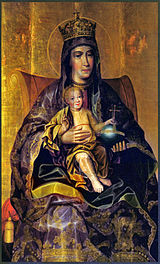
Between the early 16th and the late 17th centuries, however, an original tradition of stone tented roof architecture had been developed in Russia. It was quite unique and different from the contemporary Renaissance architecture elsewhere in Europe, though some researches call that style 'Russian Gothic' and compare it with the European Gothic architecture of the earlier period. The Italians, with their advanced technology, may have influenced the invention of the stone tented roof (the wooden tents were known in Russia and Europe long before). According to one hypothesis, an Italian architect called Petrok Maly may have been an author of the Ascension Church in Kolomenskoye, one of the earliest and most prominent tented roof churches.
By the 17th century the influence of Renaissance painting resulted in Russian icons becoming slightly more realistic, while still following most of the old icon painting canons, as seen in the works of Bogdan Saltanov, Simon Ushakov, Gury Nikitin, Karp Zolotaryov and other Russian artists of the era. Gradually the new type of secular portrait painting appeared, called parsúna (from "persona" - person), which was transitional style between abstract iconographics and real paintings.
In the mid 16th century Russians adopted printing from Central Europe, with Ivan Fyodorov being the first known Russian printer. In the 17th century printing became widespread, and woodcuts became especially popular. That led to the development of a special form of folk art known as lubok printing, which persisted in Russia well into the 19th century.
A number of technologies of Renaissance period was adopted by Russians from Europe rather early, and perfected subsequently to became a part of strong domestic tradition. Mostly these were military technologies, such as cannon casting adopted at least in the 15th century. The Tsar Cannon, which is the world's largest bombard by caliber, is the masterpiece of Russian cannon making. It was cast in 1586 by Andrey Chokhov, and is notable also by its rich relief decoration. Another technology, that according to one hypothesis originally was brought from Europe by Italians, resulted in the development of vodka, the national beverage of Russia. As early as 1386 the Genoese ambassadors brought the first aqua vitae ("the living water") to Moscow and presented it to Grand Duke Dmitry Donskoy. The Genoese likely got this beverage with the help of the alchemists of Provance, who used the Arab-invented distillation apparatus to convert grape must into alcohol. A Moscovite monk called Isidore used this technology to produce the first original Russian vodka c. 1430.
Historiography
Conception
The term was first used retrospectively by the Italian artist and critic Giorgio Vasari (1511–1574) in his book The Lives of the Artists (published 1550). In the book Vasari was attempting to define what he described as a break with the barbarities of gothic art: the arts had fallen into decay with the collapse of the Roman Empire and only the Tuscan artists, beginning with Cimabue (1240–1301) and Giotto (1267–1337) began to reverse this decline in the arts. According to Vasari, antique art was central to the rebirth of Italian art.
However, it was not until the 19th century that the French word Renaissance achieved popularity in describing the cultural movement that began in the late-13th century. The Renaissance was first defined by French historian Jules Michelet (1798–1874), in his 1855 work, Histoire de France. For Michelet, the Renaissance was more a development in science than in art and culture. He asserted that it spanned the period from Columbus to Copernicus to Galileo; that is, from the end of the 15th century to the middle of the 17th century. Moreover, Michelet distinguished between what he called, "the bizarre and monstrous" quality of the Middle Ages and the democratic values that he, as a vocal Republican, chose to see in its character. A French nationalist, Michelet also sought to claim the Renaissance as a French movement.
The Swiss historian Jacob Burckhardt (1818–1897) in his Die Cultur der Renaissance in Italien (1860), by contrast, defined the Renaissance as the period between Giotto and Michelangelo in Italy, that is, the 14th to mid-16th centuries. He saw in the Renaissance the emergence of the modern spirit of individuality, which had been stifled in the Middle Ages. His book was widely read and was influential in the development of the modern interpretation of the Italian Renaissance. However, Buckhardt has been accused of setting forth a linear Whiggish view of history in seeing the Renaissance as the origin of the modern world.
More recently, historians have been much less keen to define the Renaissance as a historical age, or even a coherent cultural movement. Randolph Starn, Historian at the University of California Berkeley, stated:
"Rather than a period with definitive beginnings and endings and consistent content in between, the Renaissance can be (and occasionally has been) seen as a movement of practices and ideas to which specific groups and identifiable persons variously responded in different times and places. It would be in this sense a network of diverse, sometimes converging, sometimes conflicting cultures, not a single, time-bound culture".
Debates about progress
There is debate about the extent to which the Renaissance improved on the culture of the Middle Ages. Both Michelet and Burckhardt were keen to describe the progress made in the Renaissance towards the modern age. Burckhardt likened the change to a veil being removed from man's eyes, allowing him to see clearly.
In the Middle Ages both sides of human consciousness – that which was turned within as that which was turned without – lay dreaming or half awake beneath a common veil. The veil was woven of faith, illusion, and childish prepossession, through which the world and history were seen clad in strange hues.—Jacob Burckhardt, The Civilization of the Renaissance in Italy
On the other hand, many historians now point out that most of the negative social factors popularly associated with the medieval period – poverty, warfare, religious and political persecution, for example – seem to have worsened in this era which saw the rise of Machiavelli, the Wars of Religion, the corrupt Borgia Popes, and the intensified witch-hunts of the 16th century. Many people who lived during the Renaissance did not view it as the " golden age" imagined by certain 19th-century authors, but were concerned by these social maladies. Significantly, though, the artists, writers, and patrons involved in the cultural movements in question believed they were living in a new era that was a clean break from the Middle Ages. Some Marxist historians prefer to describe the Renaissance in material terms, holding the view that the changes in art, literature, and philosophy were part of a general economic trend from feudalism towards capitalism, resulting in a bourgeois class with leisure time to devote to the arts.
Johan Huizinga (1872–1945) acknowledged the existence of the Renaissance but questioned whether it was a positive change. In his book The Waning of the Middle Ages, he argued that the Renaissance was a period of decline from the High Middle Ages, destroying much that was important. The Latin language, for instance, had evolved greatly from the classical period and was still a living language used in the church and elsewhere. The Renaissance obsession with classical purity halted its further evolution and saw Latin revert to its classical form. Robert S. Lopez has contended that it was a period of deep economic recession. Meanwhile George Sarton and Lynn Thorndike have both argued that scientific progress was perhaps less original than has traditionally been supposed.
Some historians have begun to consider the word Renaissance to be unnecessarily loaded, implying an unambiguously positive rebirth from the supposedly more primitive " Dark Ages" (Middle Ages). Many historians now prefer to use the term " Early Modern" for this period, a more neutral designation that highlights the period as a transitional one between the Middle Ages and the modern era. Others such as Roger Osborne have come to consider the Italian Renaissance as a repository of the myths and ideals of western history in general, and instead of rebirth of ancient ideas as a period of great innovation
Other Renaissances
The term Renaissance has also been used to define periods outside of the 15th and 16th centuries. Charles H. Haskins (1870–1937), for example, made a case for a Renaissance of the 12th century. Other historians have argued for a Carolingian Renaissance in the 8th and 9th centuries, and still later for an Ottonian Renaissance in the 10th century. Other periods of cultural rebirth have also been termed "renaissances", such as the Bengal Renaissance, al-Nahda or the Harlem Renaissance.

